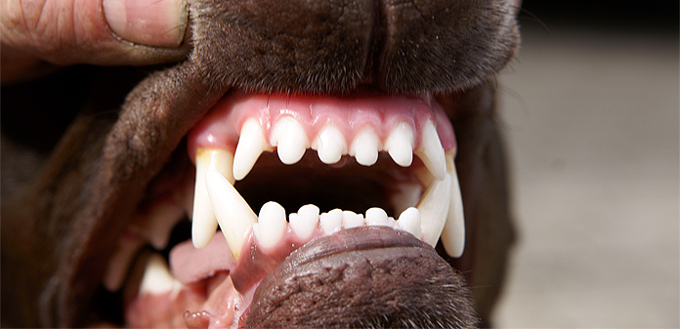Tooth fractures are one of the most common ailments to afflict dogs. Vets see and treat these types of injury on a daily basis, so if you think your canine companion might have broken a tooth try not to worry – it’s unpleasant for you both, but very treatable.
Below we take a look at what can cause a broken tooth, how to figure out if your dog has one, and how it should be treated. We’ve also put together some tips for keeping your pet’s mouth healthy – helping to prevent future oral injuries.

How Teeth Can be Broken
There isn’t a definitive list, but when dogs fracture a tooth it tends to be the result one of these culprits:
- Chewing Hard Objects
Just like humans, dogs can crack a tooth by biting down on something hard. This could be anything from a bone or particularly hard dog chew, to furniture or something else they shouldn’t be gnawing on. This type of injury tends to affect a dog’s molars – the larger teeth used for grinding and located towards the back of the mouth.
- Facial Trauma
If your dog is unlucky enough to be hit in the muzzle by something hard, or fall on their face, this can also result in one or more fractured teeth. As you can probably imagine, this is incredibly painful for the poor pooch, and you should take them to the vet’s for a check-up, regardless of whether you believe dental damage has been done. This type of injury tends to affect canine teeth – the sharp ‘fangs’ at the front of the mouth.
Identifying a Broken Tooth
We know that some dogs are reluctant, to put it mildly, to allow their owners to inspect their mouths. Because of this, it can be difficult to tell when your pet has broken a tooth. Fortunately, there are a number of signs which suggest a tooth fracture:
- Pain
- Flinching or whining when something comes near their mouth
- Trouble with eating
- Drooling more than usual
- Loss of appetite
- Swelling around the mouth
- The presence of blood in salvia
- Changes in behvior – your dog may be more irritable or appear downcast
If your dog is exhibiting one or more of these signs, it is a good idea to inspect their mouth if possible. It probably goes without saying, but this should be done as gently as possible so as not to exacerbate the pain.
Identifying a fractured tooth might seem straight-forward, but because dogs, like people, each have a unique mouth, knowing what’s normal can be a challenge. Look for jagged edges, and difference in appearance to other teeth. If the tooth is still alive, you might be able to see a red or yellowish spot; exposed dentin or marrow, which are colored differently to the enamel you would usually see. You might also observe swelling around the tooth.
During your inspection, you should check for signs of infection, too. These include abnormally bad breath, discharge, and bleeding or swollen gums. Fractured teeth are very prone to infection.

Seeking Treatment for your Dog’s Broken Tooth
If you believe that your dog has fractured a tooth, you should seek help from a veterinary professional as soon as possible. Depending on the nature and severity of the fracture, and whether or not an infection has developed, your vet will suggest different treatments. There are two main options.
- Extraction
One treatment for a broken tooth is to simply pull it out. Your vet will probably recommend this option if they don’t believe the tooth can be saved, or if doing so would cause your pet disproportionate pain and discomfort. Removing the problem tooth entirely also tends to be the least time consuming treatment. Nonetheless, extraction does not come without risks, including bleeding, remnants of the tooth being left in the gum, and infection.
- Root Canal Therapy
This kind of treatment is usually only offered by those specializing in veterinary dentistry. It involves removing the inner pulp of the tooth, before sealing it up and adding a cap. This kind of treatment can save a tooth, allowing your dog to continue using it.
Related Post: Best Bones for Dogs
Aftercare
Both of these treatments could involve putting your pet under anaesthesia, which different animals react to differently. It might take your dog a while to come round, and it’s important to keep an eye on them.
With root canal therapy, your dog could be back to their own selves very quickly, though – sometimes on the very same day as treatment. Dogs generally take longer to recover from tooth extractions, and you will need to administer pain killers and antibiotics as prescribed by your vet, as well as keeping an eye out for infections in your dog’s mouth.
Related Post: Best Dental Chews for Dogs
Protecting your Dog’s Teeth
Fractures happen, but there is plenty you can do to reduce the risk of your dog getting one, as well as promoting a healthy mouth:
- Regular Checks
Try to check your dog’s mouth for any abnormalities a couple of times a week. The more often you do this, the more your dog will get used to it. You can find tips to teach your dog to open their mouth here. By doing this regularly, you can also work out what is normal for your dog, hence better spot problems.
- Clean Teeth
Regularly brushing your dog’s teeth helps to reduce plaque build-up and steer clear of infections. Certain dog chews are also designed to help with this.
You May Also Like: Dog Toothpaste
- Avoid certain Chews
Veterinary dentists recommend that dogs should not be allowed to chew bones, tennis balls, or compressed rawhide. Ice-cubes should also be avoided, since they are not only hard, but the cold makes teeth more brittle. Instead, try offering your dog rubber chew toys, a raw carrot, dental chews, or bully bars (essentially jerky for dogs). This helps to reduce their chances of breaking a tooth.
Related Post: Best Chew Toys for Puppies
Sources:
- Dr. Jessica Riehl, Tooth Fractures, The MSPCA–Angell
- Pet dental care, American Veterinary Medical Foundation
- Anna Burke, Do Dogs Need Dental Care?, The American Kennel Club
Note: The advice provided in this post is intended for informational purposes and does not constitute medical advice regarding pets. For an accurate diagnosis of your pet's condition, please make an appointment with your vet.






